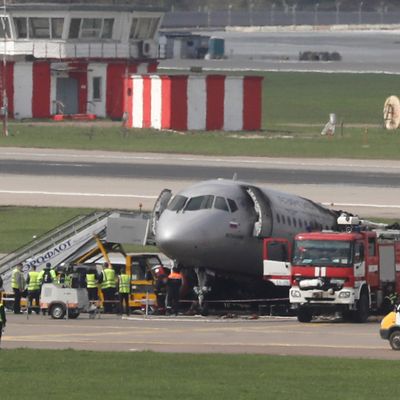
An Aeroflot passenger jet burst into flames during an emergency landing at Moscow’s Sheremetyevo airport on Sunday, resulting in a conflagration that left 41 of 78 people aboard the plane dead. The plane, a Sukhoi Superjet SSJ100 operating as Aeroflot Flight 1492, had taken off at 6:03 p.m. local time bound for the Arctic Ocean port of Murmansk. Approximately five minutes after takeoff, the pilot began a spiraling descent to return to the runway. Amateur video footage of the landing shows the plane bouncing several times before flames erupt in the tail of the aircraft. A video shot by a passenger from inside the plane shows flames engulfing the wings as panic set in inside the cabin.
While the plane was not a Boeing and did not involve a control system like the one implicated in the recent crashes of Lionair Flight 610 and Ethiopian Airlines Flight 302, the overall circumstances eerily echo the conditions that led to the loss of the two 737 Max jets. In all three cases, pilots suffered a dangerous and unexpected emergency during takeoff, lost the automation that they were used to relying on, and lacked the necessary skills to adequately handle the ensuing crisis. As such, these crashes illustrate the dangers of poorly integrating human and automatic control, a problem that will only worsen as automation becomes more ubiquitous.
While confirmed details of the Aerofloat crash remain sparse, reporting so far indicates that the plane was flying near thunderclouds at an altitude of 10,000 feet when it was struck by lightning. This caused numerous electronic malfunctions, including intermittent failure of the radio. Unable to declare Mayday verbally, the flight crew switched the aircraft’s transponder — a device that causes the plane to show up on air-traffic control radar screens with identifying information — to transmit a code for “radio failure,” and then for “emergency.” The pilot executed an emergency descent, completing one and a half turns before lining up for final approach to the runway it had taken off from 28 minutes before, according to data provided by Flightradar24.
According to statements by the flight’s pilot, Denis Evdokimov, published in the Russian newspaper Komsomolskaya Pravda, the plane’s electrical problems resulted not only in the autopilot shutting off, but in the plane’s fly-by-wire control system shifting from “normal law” (a mode in which pilots are prevented from putting the plane into a dangerous condition such as an aerodynamic stall) into “direct law” (which offers no protections).
Evdokimov thus had to fly under challenging conditions: under stress, in bad weather, and in a plane that was experiencing numerous equipment failures — notably, without the autopilot systems that pilots normally manage as they fly the approach route into a busy international airport. To make matters worse, the plane was fully laden with fuel, meaning that it was much heavier than normal. Often planes returning to land with a full fuel load will dump fuel or burn it off before attempting to touch down, but Evdokimov did not perform this procedure, perhaps out of a sense of urgency to get the plane back on the ground.
As reported in Komsomolskaya Pravda, Evdokimov claimed that on final approach “the speed was low for landing, normal” and that the plane “approached the ground smoothly, with a decrease in vertical speed.” The fact that the plane bounced several times indicates that it was going too fast: excess speed causes a plane’s wings to generate more lift than is desired, so the plane rises back into the air after touching down. If a pilot fails to handle the controls smoothly, the plane can then “porpoise” in a series of hops that can become increasingly severe. “The plane was jumping up and down like a grasshopper,” passenger Peter Egorov told Komsomolskay Pravda. As the oscillations worsen, they can result in the tail or an underslung engine striking the ground. When a ruptured fuel tank or fuel line meets with a shredded red-hot engine, a conflagration can easily result.
Because nothing in Egorov’s account suggests that the plane had suffered damage that limited its ability to land safely, investigators will likely pay particularly close attention to “human factors” — the psychological limitations that can turn an aircraft incident deadly. Under conditions of extreme stress, such as a lightning strike that causes a cascade of electrical malfunctions, the human brain experiences a phenomenon called “cognitive tunneling” that makes it hard to deal with a crisis creatively. As I write in my book, Extreme Fear: The Science of Your Mind in Danger, a person on the verge of panic is unable to process new information or come up with creative solutions. Only very well-learned habits can be performed easily. That’s why experienced pilots like “Sully” Sullenberger can pull off miracles on the Hudson, while more junior pilots can fumble a survivable crisis.
Unfortunately, while the increasing use of automation in aviation has made flying safer overall, the fact that autopilots do most of the flying these days means than human pilots spend relatively little time controlling a plane by hand, leaving them ill-equipped to take the controls in a dangerous and unfamiliar situation. “A constant theme of mine is that designers of electronic systems on airplanes assume that if something goes wrong, pilots will calmly take over,” says aviation journalist and aircraft designer Peter Garrison. “That’s not what happens. The first reaction is bafflement.” Among other recent high-profile crashes in which this dynamic played a role were Air France 447, which crashed into the Atlantic en route from Rio de Janeiro to Paris in 2009, and Air Asia 8501, which crashed into the Java Sea in 2014.
One solution to the problem would be to make sure that pilots have more training and more flight experience. That’s not the direction the world is moving, however. Global air traffic has surged in recent years, especially in the developing world, creating an acute shortage of veteran pilots. For plane makers, the challenge will be to make planes that can be flown safely by less-qualified pilots, but that also won’t dump those pilots into tough-to-handle crises when the systems malfunction.
More on the 737 Max
- Is the Boeing 737 Max Worth Saving?
- Could the 737 MAX Kill Boeing?
- The Recent Deadly Boeing Crash No One Is Talking About






























